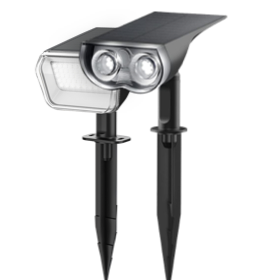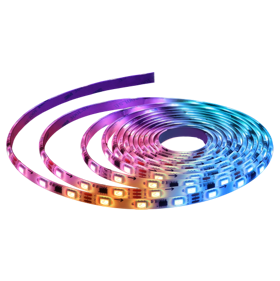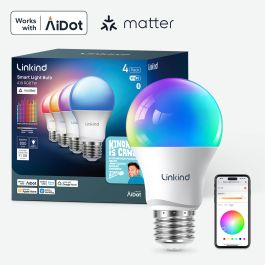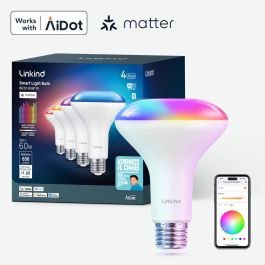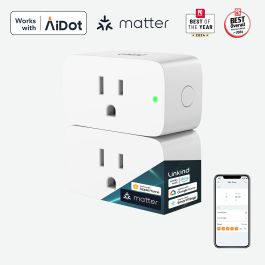How Much Do You Know about RGBW ?
How Much Do You Know about RGBW ?
RGBW is a kind of technology of sub pixel rendering, it consists of four subpixels including red, green, blue and white. RGBW strips are very similar to regular RGB strips. They have all the elements of RGB strips. The only difference is that they have an additional white LED light on top of the three LED lights, red, blue, and green. This implies that the LED chips in RGBW strips contain four different colored LEDs. Adding white LED instead of mixing the three colors to produce the white strips is because they can be slightly inconsistent. To come up with white light requires the same ratio for red, blue, and green light which can be challenging to achieve in a singular LED chip due to the uneven distribution of colors. This is why RGBW strips were created with the additional white LEDs because regular RGB strips are not great at producing excellent white light.
What is RGBW LIGHT?

A 4-in-1 chip in RGB+W LEDs adds white to the red, green, and blue colors. So, what is the deal with the extra chip? As previously stated, a conventional RGB lights are incapable of producing pure white. A dedicated white LED chip generates a significantly more refined white tone and increases the colors vibrancy. RGBW LEDs provide a more natural illumination of colorful objects and skin tones than RGB LEDs. Furthermore, RGBW strips produce significantly higher Color Rendering Index (CRI) values, allowing colored surfaces to be lighted more naturally and consistently every time. RGBW LEDs also provide a significantly wider color spectrum and more precise performance, which helps achieve full-spectrum lighting far better than RGB LEDs.
In cases when the quality of LED light is critical, the following should be considered: first, within the light engine, there are more than three hues. Therefore, RGBW LEDs may brighten your room with pure white light and create more accurate light accents. The second is that RGBW LED fixture illuminates people and colors things more naturally and accurately. Lastly, a well-balanced color ratio for straightforward mixing and brightness levels may be adjusted to produce fine and bright light desired by many people. Furthermore, with the additional color strip, which increases the intensity of the color depths, it allows a wider variety of unique color shadings when compared to the RGB LED and other common bulbs. RGBW has the following benefits, which makes them preferred to other types of bulbs.
They consume a lot less energy, last a lot longer, and come in any color one can think of. RGBW LEDs may be used to give color to one living room and, owing to the additional diode, can also be used to brighten rooms with pure white light evenly. They are also great for creating ambiance throughout the house. The simple option of colors allows one to adapt the lighting to suit their moods, whether one is resting and listening to music, needs a stimulating light for an evening with visitors, or requires a tranquil light to relax after a long day at work. RGBW LEDs may also provide harmonized, uniform lighting for reading nooks, studies, and hobby rooms, as well as anywhere else where eye strain or weariness is a concern.
In addition, the RGBW LED strip lights are incredibly eco-friendly. Unlike fluorescent and incandescent lights, they do not contain any toxic substances that damage the environment, such as mercury. They’re also made entirely of materials that are 100% recyclable. As a result, they’ll never need to go to the landfill, lowering their carbon footprint dramatically over their lifetime. Also, they have a much longer lifespan and produce less heat. After purchasing them, one does not need to replace them sooner than other conventional light sources.
Utilization of RGBW
Adding color to an area can help it become more vibrant and inviting. RGBW color control has a wide range of applications in a variety of industries. Color modification in community lighting applications, such as building facades and subways, can change the dynamic of these spaces. Lighting vertically the architecture of station entrances and archways can provide a visually pleasant and welcome effect in the transportation sector. Color is used for the welfare of service users in sensory rooms in the secure health sector. RGBW color can assist in energizing our moods or soothe us by stimulating our senses.
In addition, RGBW LED tapes earn bonus points because of the added white-emitting LED chip which produces sufficient light. Therefore, they provide considerably more freedom in terms of the color spectrum available. Above all, it allows for the production of true white light in various color temperatures, depending on the requirements and purpose. This saves energy since not all LED chips need to run at maximum speed to provide white light.
1. RGBW Lights and RGBW Controllers
Besides, RGBW LEDs have incorporated technology in manufacturing their lights such that they have made them compatible with Alexa and Google Home. This gives one the flexibility to turn them on and off, change the color, and change the intensity of the brightness level through the voice commands that do not require any hub. Furthermore, Linkind smart RGBW led light has a 2700K warm white color temperature for daily illumination and 16 million color selections for creating the optimum mood for various situations. Each color can be dimmed in a range of 3% to 100%. It’s quite simple to set up using the Linkind app. The mobile application comes with unique features that offer an alarm feature that helps one get up in the morning, have a light illuminated for you when you return home at night, and have the lights turn off automatically when you go to bed.
They are very convenient to use and allow group controls. This is mostly in the Linkind Smart E14 LED light bulbs, which can be set to multiple rooms in the app. One can then modify the entire group at once or press individual lights to create different moods in the different rooms.
2. RGBW LED Strip
Also, RGBW strips are best used in areas where a high level of light quality is required and a cleaner light mixture is desired. In most cases, the RGBW LED is used in commercial buildings where human comfort is the top priority. It is utilized to mimic the natural illumination variations that the sun undergoes throughout the day. This is because humans are physiologically structured to function with the sun signals. It is simply not possible to get enough sunshine when sitting all day indoors in places like offices. This is where RGBW LED strips and their ability to shift temperature from chilly to warm white come into play. People emulate the sun inside buildings by gradually changing the white coloring to mimic the sun’s natural light pattern. This notion is an essential aspect of Human Centric Lighting. It is employed in buildings worldwide to improve the working environment, which also helps increase productivity.
Conclusion
In conclusion, RGBW LEDs are a game-changer in the lighting industry. They offer energy efficiency, a wide range of colors, and compatibility with smart home systems. Whether you're looking to create a cozy atmosphere at home, enhance your workspace, or promote a more sustainable environment, RGBW LED lights are a fantastic choice. Their versatility and eco-friendly nature make them a top pick for modern lighting solutions. So, how much do you know about RGBW? Now you know enough to consider integrating them into your lighting plans.












